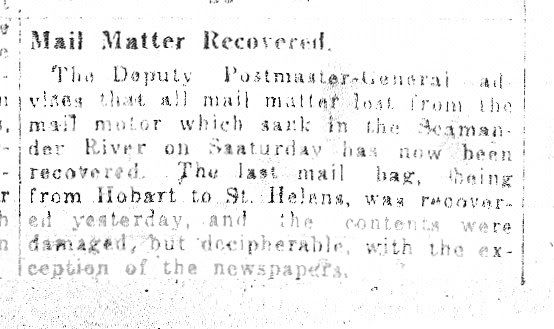Scamander Mail Accident - 1924
Posted: Thu Jun 18, 2009 1:31 pm
I found the following report in The Mercury Thurs 10 April 1924:

The report does not give the exact location of the accident, but it is probably where the (present day) two bridges cross the Scamander River near the beach.
A very interesting short history of the bridges at Scamander can be found on the SMH site, the relevant portion of which is extracted here:
"The town's most interesting historic attraction is its infamous bridge. The Scamander River is sufficiently wide to present anyone travelling along the coast with a problem. This was certainly the case when Surveyor Wedge tried to traverse it in 1825. The first bridge, a flimsy thing with pylons no thicker than an average telegraph post, was constructed by Richard Terry in 1865 and lasted until it collapsed under the weight of a mob of cattle.
It was replaced by an ironbark and bluegum bridge which lasted until 1889 when a particularly heavy flood simply washed it away. The mail coach was the last vehicle to pass across it.
The third bridge was built by Grubb Bros. for £4,500. It was built from ironbark and lasted a record of 22 years until the flood of 1911, sending numerous trees down the river, put such pressure on the bridge it collapsed.
After this a series of bridges were constructed but they were all destroyed either by flood or the dreaded toredo, a voracious borer which worked its way into the timber quickly destroying it. The last wooden bridge collapsed in 1929 and the town was forced to rely on a punt across the river until a concrete bridge was built in 1936. It has finally been replaced by a new bridge which the town is hoping will last indefinitely".
The State Library collection contains two postcards of the bridge which are reproduced below. The site does not illustrate the backs of the cards and is not very reliable when it comes to the publishers of the cards. The Scamander group of 6 cards is noted to "incl. S Spurling". No doubt the font on the first card could enable someone to identify the publisher and give an approximate date of publication. The second card may be a real photo postcard. Presumably the two cards depict the Grubb Bros. bridge which was washed away in 1911.



The report does not give the exact location of the accident, but it is probably where the (present day) two bridges cross the Scamander River near the beach.
A very interesting short history of the bridges at Scamander can be found on the SMH site, the relevant portion of which is extracted here:
"The town's most interesting historic attraction is its infamous bridge. The Scamander River is sufficiently wide to present anyone travelling along the coast with a problem. This was certainly the case when Surveyor Wedge tried to traverse it in 1825. The first bridge, a flimsy thing with pylons no thicker than an average telegraph post, was constructed by Richard Terry in 1865 and lasted until it collapsed under the weight of a mob of cattle.
It was replaced by an ironbark and bluegum bridge which lasted until 1889 when a particularly heavy flood simply washed it away. The mail coach was the last vehicle to pass across it.
The third bridge was built by Grubb Bros. for £4,500. It was built from ironbark and lasted a record of 22 years until the flood of 1911, sending numerous trees down the river, put such pressure on the bridge it collapsed.
After this a series of bridges were constructed but they were all destroyed either by flood or the dreaded toredo, a voracious borer which worked its way into the timber quickly destroying it. The last wooden bridge collapsed in 1929 and the town was forced to rely on a punt across the river until a concrete bridge was built in 1936. It has finally been replaced by a new bridge which the town is hoping will last indefinitely".
The State Library collection contains two postcards of the bridge which are reproduced below. The site does not illustrate the backs of the cards and is not very reliable when it comes to the publishers of the cards. The Scamander group of 6 cards is noted to "incl. S Spurling". No doubt the font on the first card could enable someone to identify the publisher and give an approximate date of publication. The second card may be a real photo postcard. Presumably the two cards depict the Grubb Bros. bridge which was washed away in 1911.

